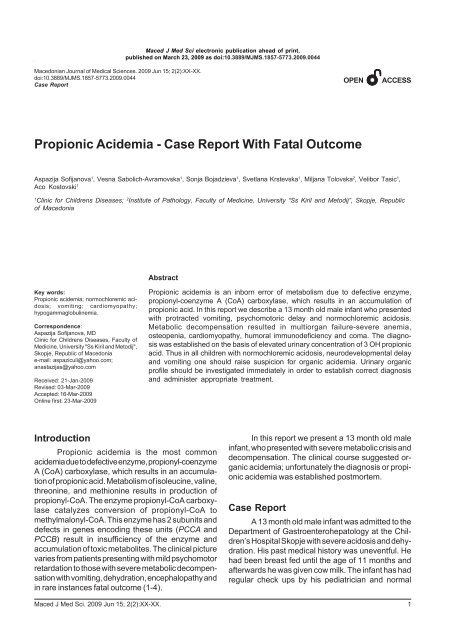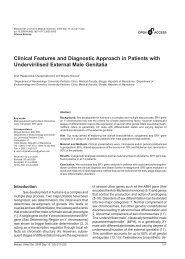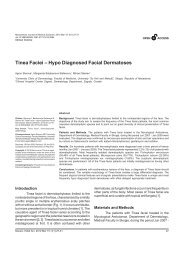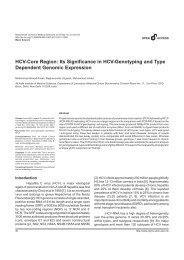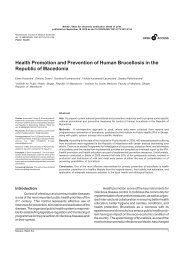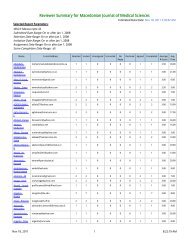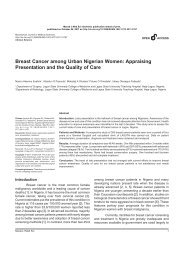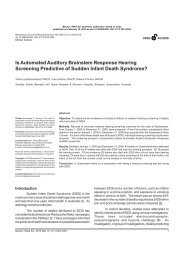Propionic Acidemia - Case Report With Fatal Outcome
Propionic Acidemia - Case Report With Fatal Outcome
Propionic Acidemia - Case Report With Fatal Outcome
Create successful ePaper yourself
Turn your PDF publications into a flip-book with our unique Google optimized e-Paper software.
Maced J Med Sci electronic publication ahead of print,<br />
published on March 23, 2009 as doi:10.3889/MJMS.1857-5773.2009.0044 Sofijanova et al. <strong>Propionic</strong> <strong>Acidemia</strong><br />
Macedonian Journal of Medical Sciences. 2009 Jun 15; 2(2):XX-XX.<br />
doi:10.3889/MJMS.1857-5773.2009.0044<br />
<strong>Case</strong> <strong>Report</strong><br />
OPENACCESS<br />
<strong>Propionic</strong> <strong>Acidemia</strong> - <strong>Case</strong> <strong>Report</strong> <strong>With</strong> <strong>Fatal</strong> <strong>Outcome</strong><br />
Aspazija Sofijanova 1 , Vesna Sabolich-Avramovska 1 , Sonja Bojadzieva 1 , Svetlana Krstevska 1 , Miljana Tolovska 2 , Velibor Tasic 1 ,<br />
Aco Kostovski 1<br />
1<br />
Clinic for Childrens Diseases; 2 Institute of Pathology, Faculty of Medicine, University “Ss Kiril and Metodij”, Skopje, Republic<br />
of Macedonia<br />
Abstract<br />
Key words:<br />
<strong>Propionic</strong> acidemia; normochloremic acidosis;<br />
vomiting; cardiomyopathy;<br />
hypogammaglobulinemia.<br />
Correspondence:<br />
Aspazija Sofijanova, MD<br />
Clinic for Childrens Diseases, Faculty of<br />
Medicine, University "Ss Kiril and Metodij",<br />
Skopje, Republic of Macedonia<br />
e-mail: aspaziculi@yahoo.com;<br />
anastazijas@yahoo.com<br />
Received: 21-Jan-2009<br />
Revised: 03-Mar-2009<br />
Accepted: 16-Mar-2009<br />
Online first: 23-Mar-2009<br />
<strong>Propionic</strong> acidemia is an inborn error of metabolism due to defective enzyme,<br />
propionyl-coenzyme A (CoA) carboxylase, which results in an accumulation of<br />
propionic acid. In this report we describe a 13 month old male infant who presented<br />
with protracted vomiting, psychomotoric delay and normochloremic acidosis.<br />
Metabolic decompensation resulted in multiorgan failure-severe anemia,<br />
osteopenia, cardiomyopathy, humoral immunodeficiency and coma. The diagnosis<br />
was established on the basis of elevated urinary concentration of 3 OH propionic<br />
acid. Thus in all children with normochloremic acidosis, neurodevelopmental delay<br />
and vomiting one should raise suspicion for organic acidemia. Urinary organic<br />
profile should be investigated immediately in order to establish correct diagnosis<br />
and administer appropriate treatment.<br />
Introduction<br />
<strong>Propionic</strong> acidemia is the most common<br />
acidemia due to defective enzyme, propionyl-coenzyme<br />
A (CoA) carboxylase, which results in an accumulation<br />
of propionic acid. Metabolism of isoleucine, valine,<br />
threonine, and methionine results in production of<br />
propionyl-CoA. The enzyme propionyl-CoA carboxylase<br />
catalyzes conversion of propionyl-CoA to<br />
methylmalonyl-CoA. This enzyme has 2 subunits and<br />
defects in genes encoding these units (PCCA and<br />
PCCB) result in insufficiency of the enzyme and<br />
accumulation of toxic metabolites. The clinical picture<br />
varies from patients presenting with mild psychomotor<br />
retardation to those with severe metabolic decompensation<br />
with vomiting, dehydration, encephalopathy and<br />
in rare instances fatal outcome (1-4).<br />
Maced J Med Sci. 2009 Jun 15; 2(2):XX-XX.<br />
In this report we present a 13 month old male<br />
infant, who presented with severe metabolic crisis and<br />
decompensation. The clinical course suggested organic<br />
acidemia; unfortunately the diagnosis or propionic<br />
acidemia was established postmortem.<br />
<strong>Case</strong> <strong>Report</strong><br />
A 13 month old male infant was admitted to the<br />
Department of Gastroenterohepatology at the Children’s<br />
Hospital Skopje with severe acidosis and dehydration.<br />
His past medical history was uneventful. He<br />
had been breast fed until the age of 11 months and<br />
afterwards he was given cow milk. The infant has had<br />
regular check ups by his pediatrician and normal<br />
1
<strong>Case</strong> <strong>Report</strong><br />
psychomotor and growth milestones. Since the age of<br />
11 months he began to vomit and his motor development<br />
arrested. He has lost 2 kilograms for two months.<br />
He has been constipated for seven days before<br />
this admission. His vomiting intensified in the last days<br />
and was referred to the local hospital. Besides parenteral<br />
hydration his general status did not improve and he<br />
was referred to our Institution. On admission he was<br />
severely dehydrated but alert. On the day of admission<br />
he had electrolyte determination at the local hospital<br />
(Na, K and Cl were within normal limits). His acid base<br />
status showed severe metabolic acidosis (HCO 3<br />
lowest<br />
value 7.3 mmol/l). His urine showed pH 5 and<br />
ketones 3+, no glucose. There was hypercalciuriacalcium/creatinine<br />
ratio was 2.34 (normal < 2.0).<br />
Chest X-ray showed bilateral pneumonia. The bones<br />
showed osteoporosis (Figure 1). He was given intravenous<br />
fluids, glucose and bicarbonate and his general<br />
state improved. He started oral feedings, but he became<br />
again dehydrated and acidotic. His general state<br />
worsened and he presented with weakness, hypotonia,<br />
sopor, tachypnea and dyspnea. The laboratory<br />
investigation revealed severe metabolic acidosis, mildly<br />
increased serum anion gap at 18 mmol/l, with normal<br />
chloride 105 mmol/l. Urine pH was 5 (with dipstick). His<br />
kidney ultrasound was normal. There was mild<br />
hypokalemia (3.1 mmol/l) hypophosphatemia (0.91<br />
mmol/l) and hypouricemia (136 micromol/l) suggesting<br />
tubular dysfunction. Chloride highest value 109<br />
mmol/l during severe acidosis. Although his hematologic<br />
parameters were within normal range on admission he<br />
developed severe anemia (Hb 72 g/l) which required<br />
transfusion of packed red cells. His platelet count<br />
decreased to 46x10 11 /l. He revealed humoral immunodeficiency:<br />
IgG 1.3 g/l, IgM 0.7 g/l, IgA 0.2 g/l.<br />
Echocardiography showed poor kinetics of the left<br />
ventricle. Besides intensive treatment and mechanical<br />
support, his cardiac, pulmonary and neurologically<br />
status worsened and he died. Vomiting and loss of<br />
weight, neurodevelopmental delay, constipation,<br />
normochloremic acidosis, hypogammaglobulinemia,<br />
development of anemia and cardiopathy raised suspicion<br />
for organic acidemia and therefore biological<br />
material was obtained before exitus. The assay of the<br />
urinary organic acids revealed increased concentration<br />
of 3 OH propionioc acid (55 umol/mol creatinine;<br />
normal
Sofijanova et al. <strong>Propionic</strong> <strong>Acidemia</strong><br />
Discussion<br />
<strong>Propionic</strong> acidemia is the most common organic<br />
acidemia with the estimated prevalence between<br />
1:35,000-75,000/population. The true prevalence is not<br />
known since the patients with the early onset form die<br />
in the neonatal period often misdiagnosed as sepsis.<br />
<strong>With</strong> the neonatal screening more cases are diagnosed<br />
and with appropriate medical measures these<br />
babies survive (5). The patients with late form may<br />
present with neurological symptoms characterized<br />
with severe movement disorders and dystonia (4).<br />
The disease has relapsing course of severe<br />
metabolic ketoacidosis, often precipitated by excessive<br />
protein intake, constipation, or intercurrent infection.<br />
Ketoacidosis develops because propionic acid<br />
inhibits citric acid cycle enzymes. Along with the<br />
acidosis, manifestations of the disease may include<br />
seizures, neurodevelopmental retardation, hypotonia,<br />
coma, episodic vomiting/gastroesophageal reflux, protein<br />
intolerance, hyperammonemia, hypogammaglobulinemia,<br />
bone marrow dysfunction, osteopenia,<br />
pancreatitis, and cardiomyopathy (1, 3, 4, 6-8). The<br />
initial treatment in metabolic crisis includes intravenous<br />
fluids, glucose and bicarbonate; after improvement<br />
oral feeding consists of diet that is low in proteins<br />
with supplements of carnitine, and biotin (2).<br />
It is an autosomal recessive disorder caused by<br />
mutations in PCCA and PCCB genes which encode a<br />
and b subunits of PCC, respectively. Prenatal diagnosis<br />
is possible with measurement of the abnormal<br />
metabolites in the amniotic fluid (9-11). If the gene<br />
defect is known in the family than molecular diagnosis<br />
is more acceptable. Recently a group form Spain<br />
demonstrated that non-invasive prenatal diagnosis is<br />
possible by studying maternal plasma from a pregnant<br />
woman at risk of having a fetus affected with propionic<br />
acidemia (9). It is known that 3-6% of the total plasma<br />
DNA in pregnant women has fetal origin. <strong>Propionic</strong><br />
acidemia is a recessive disorder in which about 80% of<br />
patients are compound heterozygotes. If paternal<br />
mutation in not detected in the plasma than the fetus<br />
is not affected by the disease and there is no need for<br />
amniocenthesis.<br />
Our patient presented with very unusual features:<br />
slight neurodevelopmental delay, constipation,<br />
vomiting, acidosis, anemia, cardiopathy and<br />
hypogammaglobulinemia. These features are result of<br />
the toxic effect of the organic acids particularly on bone<br />
marrow, heart, B cells and brain tissue. Long lasting<br />
acidosis leads to osteopenia and release of buffering<br />
calcium salts and hypercalcirua which may produce<br />
confusion with renal tubular acidosis. Although serum<br />
Maced J Med Sci. 2009 Jun 15; 2(2):XX-XX.<br />
anion gap was mildly increased in our patient, normal<br />
chloride during severe systemic acidosis alerted us<br />
towards organic acidemia. Thus in all children with<br />
normochloremic acidosis, neurodevelopmental delay<br />
and vomiting one should raise suspicion for organic<br />
acidemia. Urinary organic acids should be investigated<br />
immediately in order to establish correct diagnosis and<br />
administer appropriate treatment.<br />
Acknowledgments<br />
The authors would like to gratefully acknowledge Prof.<br />
A. Das and Priv. Doc. T. Lucke, Medizinische Hoch<br />
Schule Hannover for performing urinary organic profile.<br />
References<br />
1. Lücke T, Pérez-Cerdá C, Baumgartner M, Fowler B,<br />
Sander S, Sasse M, Scholl S, Ugarte M, Das AM. <strong>Propionic</strong><br />
acidemia: unusual course with late onset and fatal<br />
outcome. Metabolism. 2004; 53:809-10<br />
2. Harker HE, Emhardt JD, Hainline BE. <strong>Propionic</strong><br />
acidemia in a four-month-old male: a case study and<br />
anesthetic implications. Anesth Analg. 2000; 91:309-11.<br />
3. Delgado C, Macías C, de la Sierra García-Valdecasas<br />
M, Pérez M, del Portal LR, Jiménez LM.Subacute presentation<br />
of propionic acidemia. J Child Neurol. 2007;<br />
22:1405-7.<br />
4. Feliz B, Witt DR, Harris BT. <strong>Propionic</strong> acidemia: a neuropathology<br />
case report and review of prior cases. Arch<br />
Pathol Lab Med. 2003; 127:e325-8<br />
5. La Marca G, Malvagia S, Pasquini E, Innocenti M, Donati<br />
MA, Zammarchi E. Rapid 2nd-tier test for measurement<br />
of 3-OH-propionic and methylmalonic acids on dried blood<br />
spots: reducing the false-positive rate for<br />
propionylcarnitine during expanded newborn screening<br />
by liquid chromatography-tandem mass spectrometry.<br />
Clin Chem. 2007; 53: 1364-9.<br />
6. Mardach R, Verity MA, Cederbaum SD. Clinical, pathological,<br />
and biochemical studies in a patient with propionic<br />
acidemia and fatal cardiomyopathy. Mol Genet Metab.<br />
2005; 85: 286-90<br />
7. Jameson E, Walter J. Cardiac arrest secondary to long<br />
QT(C )in a child with propionic acidemia. Pediatr Cardiol.<br />
2008; 29:969-70.<br />
8. Griffin TA, Hostoffer RW, Tserng KY, Lebovitz DJ, Hoppel<br />
CL, Mosser JL, Kaplan D, Kerr DS. Parathyroid hormone<br />
resistance and B cell lymphopenia in propionic acidemia.<br />
Acta Paediatr. 1996; 85:875-8<br />
9. Bustamante-Aragones A, Pérez-Cerdá C, Pérez B, de<br />
Alba MR, Ugarte M, Ramos C. Prenatal diagnosis in<br />
3
<strong>Case</strong> <strong>Report</strong><br />
maternal plasma of a fetal mutation causing propionic<br />
acidemia. Mol Genet Metab. 2008; 95:101-3.<br />
10.Inoue Y, Ohse M, Shinka T, Kuhara T. Prenatal diagnosis<br />
of propionic acidemia by measuring methylcitric acid<br />
in dried amniotic fluid on filter paper using GC/MS. J<br />
Chromatogr B Analyt Technol Biomed Life Sci. 2008;<br />
870:160-3<br />
11. Pérez-Cerdá C, Pérez B, Merinero B, Desviat LR,<br />
Rodríguez-Pombo P, Ugarte M. Prenatal diagnosis of propionic<br />
acidemia. Prenat Diagn. 2004; 24: 962-4.<br />
4<br />
http://www.mjms.ukim.edu.mk


